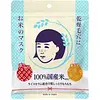What's inside
What's inside
 Key Ingredients
Key Ingredients

 Benefits
Benefits

 Concerns
Concerns

 Ingredients Side-by-side
Ingredients Side-by-side

Water
Skin ConditioningGlycerin
HumectantPropylene Glycol
HumectantAlcohol Denat.
AntimicrobialStyrene/Vp Copolymer
Lactobacillus/Rice Ferment Filtrate
Skin ConditioningOryza Sativa Bran Oil
EmollientHydrolyzed Rice Bran Extract
Skin ConditioningGlycosphingolipids
EmollientGlucosyl Ceramide
Skin ConditioningAlpha-Glucan
HumectantButylene Glycol
HumectantXanthan Gum
EmulsifyingPolysorbate 80
EmulsifyingCitric Acid
BufferingSodium Citrate
BufferingPhenoxyethanol
PreservativeMethylparaben
PreservativeWater, Glycerin, Propylene Glycol, Alcohol Denat., Styrene/Vp Copolymer, Lactobacillus/Rice Ferment Filtrate, Oryza Sativa Bran Oil, Hydrolyzed Rice Bran Extract, Glycosphingolipids, Glucosyl Ceramide, Alpha-Glucan, Butylene Glycol, Xanthan Gum, Polysorbate 80, Citric Acid, Sodium Citrate, Phenoxyethanol, Methylparaben
Water
Skin ConditioningPropanediol
SolventGlycerin
HumectantCetyl Ethylhexanoate
EmollientTriethylhexanoin
MaskingHydrogenated Rapeseed Oil
EmollientAlcohol
AntimicrobialGlyceryl Stearate
EmollientPolysorbate 60
EmulsifyingOryza Sativa Lees Extract
Skin ConditioningRice Ferment Lees
HumectantHydrolyzed Yeast Extract
Skin ConditioningCucumis Sativus Fruit Extract
EmollientGlycosphingolipids
EmollientCitrus Junos Extract
AntioxidantDipotassium Glycyrrhizate
HumectantHydrolyzed Hyaluronic Acid
HumectantHydrolyzed Collagen
EmollientMomordica Charantia Fruit Extract
Skin ConditioningIsomerized Safflower Acid
Skin ConditioningHydrogenated Lecithin
EmulsifyingHydrogenated Lysolecithin
EmulsifyingStearic Acid
CleansingButylene Glycol
HumectantPentylene Glycol
Skin ConditioningDimethicone
EmollientAmmonium Polyacrylate
StabilisingAluminum Hydroxide
EmollientArginine
MaskingCitric Acid
BufferingMicrocrystalline Cellulose
AbsorbentCarbomer
Emulsion StabilisingSodium Polyacrylate Starch
AbsorbentTitanium Dioxide
Cosmetic ColorantCaramel
Cosmetic ColorantPhenoxyethanol
PreservativeMethylparaben
PreservativeParfum
MaskingWater, Propanediol, Glycerin, Cetyl Ethylhexanoate, Triethylhexanoin, Hydrogenated Rapeseed Oil, Alcohol, Glyceryl Stearate, Polysorbate 60, Oryza Sativa Lees Extract, Rice Ferment Lees, Hydrolyzed Yeast Extract, Cucumis Sativus Fruit Extract, Glycosphingolipids, Citrus Junos Extract, Dipotassium Glycyrrhizate, Hydrolyzed Hyaluronic Acid, Hydrolyzed Collagen, Momordica Charantia Fruit Extract, Isomerized Safflower Acid, Hydrogenated Lecithin, Hydrogenated Lysolecithin, Stearic Acid, Butylene Glycol, Pentylene Glycol, Dimethicone, Ammonium Polyacrylate, Aluminum Hydroxide, Arginine, Citric Acid, Microcrystalline Cellulose, Carbomer, Sodium Polyacrylate Starch, Titanium Dioxide, Caramel, Phenoxyethanol, Methylparaben, Parfum
 Reviews
Reviews

Ingredients Explained
These ingredients are found in both products.
Ingredients higher up in an ingredient list are typically present in a larger amount.
Butylene Glycol (or BG) is used within cosmetic products for a few different reasons:
Overall, Butylene Glycol is a safe and well-rounded ingredient that works well with other ingredients.
Though this ingredient works well with most skin types, some people with sensitive skin may experience a reaction such as allergic rashes, closed comedones, or itchiness.
Learn more about Butylene GlycolCitric Acid is an alpha hydroxy acid (AHA) naturally found in citrus fruits like oranges, lemons, and limes.
Like other AHAs, citric acid can exfoliate skin by breaking down the bonds that hold dead skin cells together. This helps reveal smoother and brighter skin underneath.
However, this exfoliating effect only happens at high concentrations (20%) which can be hard to find in cosmetic products.
Due to this, citric acid is usually included in small amounts as a pH adjuster. This helps keep products slightly more acidic and compatible with skin's natural pH.
In skincare formulas, citric acid can:
While it can provide some skin benefits, research shows lactic acid and glycolic acid are generally more effective and less irritating exfoliants.
Most citric acid used in skincare today is made by fermenting sugars (usually from molasses). This synthetic version is identical to the natural citrus form but easier to stabilize and use in formulations.
Read more about some other popular AHA's here:
Learn more about Citric AcidGlycerin is already naturally found in your skin. It helps moisturize and protect your skin.
A study from 2016 found glycerin to be more effective as a humectant than AHAs and hyaluronic acid.
As a humectant, it helps the skin stay hydrated by pulling moisture to your skin. The low molecular weight of glycerin allows it to pull moisture into the deeper layers of your skin.
Hydrated skin improves your skin barrier; Your skin barrier helps protect against irritants and bacteria.
Glycerin has also been found to have antimicrobial and antiviral properties. Due to these properties, glycerin is often used in wound and burn treatments.
In cosmetics, glycerin is usually derived from plants such as soybean or palm. However, it can also be sourced from animals, such as tallow or animal fat.
This ingredient is organic, colorless, odorless, and non-toxic.
Glycerin is the name for this ingredient in American English. British English uses Glycerol/Glycerine.
Learn more about GlycerinGlycosphingolipids are naturally found in the cell membranes of organisms. In animals, they are the major glycolipids found.
Glyolipids help ensure the stability of cell membranes. They also help with cellular recognition, such as allowing cells to form tissues in skin.
Methylparaben is a preservative and is a paraben. It is used to prevent the growth of fungus, mold, and other harmful bacteria. Parabens are chemicals used as preservatives in both cosmetics and food.
Methylparaben can be synthetically created. It can also be found naturally in some fruits, such as blueberries.
Oftentimes, Methylparaben is combined with other parabens to help increase the shelf life.
The safety of Methylparaben is currently being studied. While ongoing studies are looking into the safety of parabens, the results have been very mixed. Some studies have not found Methylparaben to be harmful.
Learn more about MethylparabenPhenoxyethanol is a preservative that has germicide, antimicrobial, and aromatic properties. Studies show that phenoxyethanol can prevent microbial growth. By itself, it has a scent that is similar to that of a rose.
It's often used in formulations along with Caprylyl Glycol to preserve the shelf life of products.
Water. It's the most common cosmetic ingredient of all. You'll usually see it at the top of ingredient lists, meaning that it makes up the largest part of the product.
So why is it so popular? Water most often acts as a solvent - this means that it helps dissolve other ingredients into the formulation.
You'll also recognize water as that liquid we all need to stay alive. If you see this, drink a glass of water. Stay hydrated!
Learn more about Water